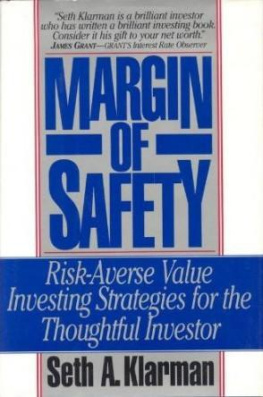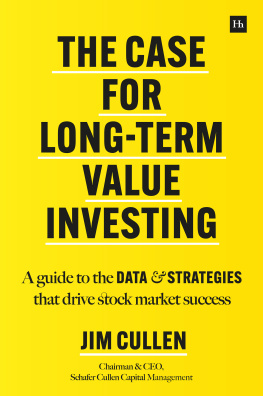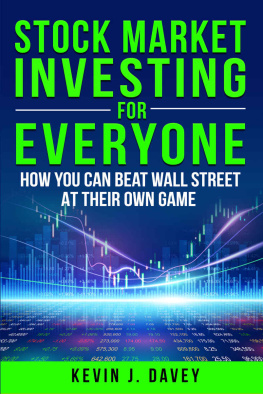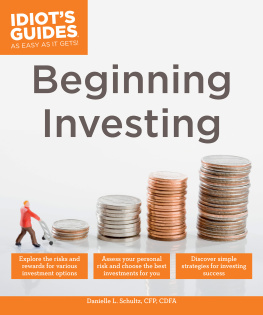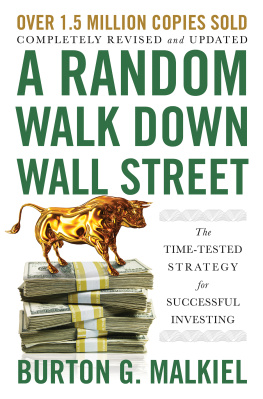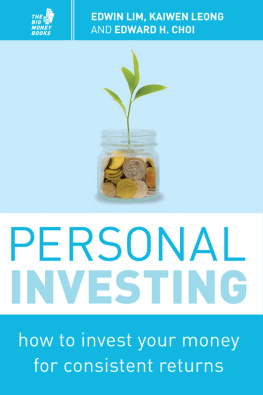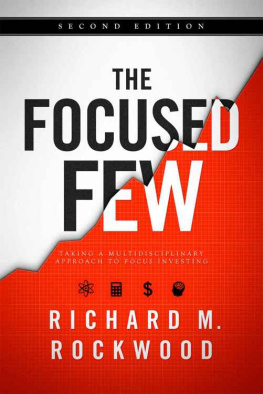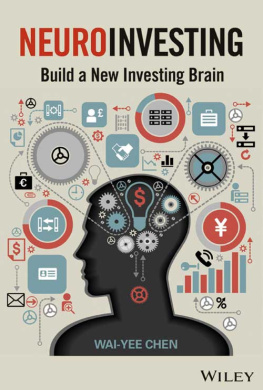MARGIN OF SAFETY
Risk-Averse Value Investing Strategies for the Thoughtful Investor
Seth A. Klarman
Contents
Available from the Kindle Menu button under Go To
Acknowledgments
While always interested in the workings of Wall Street, I was extremely fortunate in my first real job to have the opportunity to work alongside Michael Price and the late Max L. Heine at Mutual Shares Corporation (now Mutual Series Fund, Inc.). My uncle Paul Friedman always encouraged my interest in investing and helped me land that job. I look back on my experience at Mutual Shares very fondly. My learning in the two years working with Max and Mike probably eclipsed what I learned in the subsequent two years at Harvard Business School. It is to Maxs memory that I dedicate this book.
After earning my MBA at Harvard, I was faced with several exciting career choices. The unconventional offer to join a startup investment-management firm in Cambridge, Massachusetts, presented the opportunity to begin building an investment track record early in my career. And so it was that I joined Bill Poorvu, Isaac Auerbach, Jordan Baruch, Howard Stevenson, and Jo-An Bosworth in forming the Baupost Group. Each of my colleagues Howard in particular went out on a long, thin limb to bet on me and my abilities, not only to manage their own money but also that of their families and close friends, which was perhaps the greater act of faith. It has been my great privilege to be associated with such knowledgeable, energetic, warm, and caring people. Together we have built something to be proud of.
It has also been a privilege to work alongside Paul OLeary, David Abrams, and now Tom Knott, my brilliant and dedicated investment team and in-house doubles game. I am grateful to each of them for his many insights and observations, a number of which appear in one form or another in this work.
I am also fortunate to have some of the finest clients a professional investor could have. A number of them encouraged me in this endeavor. While I shall respect their privacy by not naming them, their patience, interest, and support have been key elements in our investment success.
My nine years at Baupost have brought me into contact with many of the finest people in the investment business, on both the buy side and the sell side. I am grateful to each of them for teaching me so much about this business and for putting up with me when I was having a bad day. Though they are too numerous to thank individually, I owe each of them a great deal.
I do wish to thank the people who have been especially helpful with this project. My colleagues at Baupost Howard, David, Paul, and Tom each reviewed the manuscript as it neared completion as did four special friends, Lou Lowenstein, David Darst, Henry Emerson, and Bret Fromson. A number of other friends made very helpful suggestions at earlier stages of this project. Jess Ravich, in particular, offered many valuable insights into the junk-bond and bankruptcy sections. Finally, Jim Grant, perhaps without realizing it, inspired me to take on this challenge. I thank each of them for their help, and far more important, I will always cherish their friendship.
My wife, Beth Klarman, offered the fresh perspective of a non-financial-professional as she devotedly read every chapter and made numerous helpful recommendations. She also made every accommodation to help free up time for me to devote to this project and urged me to press on to completion the many times when progress was slow. I thank her for being a great wife and mother and my best friend.
My father, Herb Klarman, was perhaps the most careful reader of multiple drafts of this manuscript. He is a true craftsman of the art of writing, and his comments are literally incorporated on every page of this book. I thank him for his tremendous assistance. I also want to thank my mother, Muriel Klarman, for teaching me to ask questions and encouraging me to discover the answers.
Finally I must acknowledge the extraordinary efforts of Mark Greenberg, my editor at HarperBusiness, and Mitch Tuchman, my developmental editor, in improving this manuscript in so many ways. I thank them both for their help in seeing this project to fruition. I also owe thanks to Martha Jewett, who made helpful comments on an early draft, and special thanks to Virginia Smith, who proposed this project out of the blue.
Jacqui Fiorenza, Mike Hammond, and Susie Spero were of enormous assistance with the typing and retyping of this manuscript. Kathryn Potts made numerous editorial suggestions and helped to prepare the glossary. Carolyn Beckedorff provided research assistance as needed.
As with any work such as this, full responsibility for errors must be borne by the author. I hope those that remain are minor and few in number.
Introduction
Investors adopt many different approaches that offer little or no real prospect of long-term success and considerable chance of substantial economic loss. Many are not coherent investment programs at all but instead resemble speculation or outright gambling. Investors are frequently lured by the prospect of quick and easy gain and fall victim to the many fads of Wall Street. My goals in writing this book are twofold. Inthe first section I identify many of the pitfalls that face investors. By highlighting where so many go wrong, I hope to help investors learn to avoid these losing strategies.
For the remainder of the book I recommend one particular path for investors to follow-a value-investment philosophy. Value investing, the strategy of investing in securities trading at an appreciable discount from underlying value, has a long history of delivering excellent investment results with very limited downside risk. This book explains the philosophy of value investing and, perhaps more importantly, the logic behind it in an attempt to demonstrate why it succeeds while other approaches fail.
I have chosen to begin this book, not with a discussion of what value investors do right, but with an assessment of where other investors go wrong, for many more investors lose their way along the road to investment success than reach their destination. It is easy to stray but a continuous effort to remain disciplined. Avoiding where others go wrong is an important step in achieving investment success. In fact, it almost ensures it.
You may be wondering, as several of my friends have, why I would write a book that could encourage more people to become value investors. Dont I run the risk of encouraging increased competition, thereby reducing my own investment returns? Perhaps, but I do not believe this will happen. For one thing, value investing is not being discussed here for the first time. While I have tried to build the case for it somewhat differently from my predecessors and while my precise philosophy may vary from that of other value investors, a number of these views have been expressed before, notably by Benjamin Graham and David Dodd, who more than fifty years ago wrote Security Analysis, regarded by many as the bible of value investing. That single work has illuminated the way for generations of value investors. More recently Graham wrote The Intelligent Investor, a less academic description of the value-investment process. Warren Buffett, the chairman of Berkshire Hathaway, Inc., and a student of Graham, is regarded as todays most successful value investor. He has written countless articles and shareholder and partnership letters that together articulate his value-investment philosophy coherently and brilliantly. Investors who have failed to heed such wise counsel are unlikely to listen tome.
The truth is, I am pained by the disastrous investment results experienced by great numbers of unsophisticated or undisciplined investors. If I can persuade just a few of them to avoid dangerous investment strategies and adopt sound ones that are designed to preserve and maintain their hard-earned capital, I will be satisfied. If I should have a wider influence on investor behavior, then I would gladly pay the price of a modest diminution in my own investment returns.
Next page
